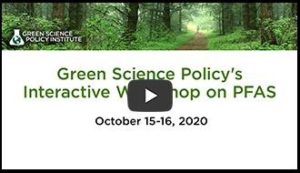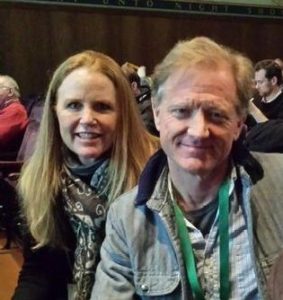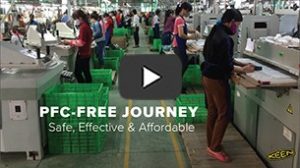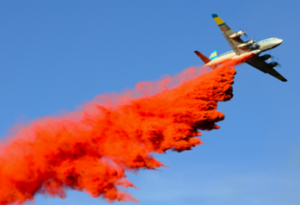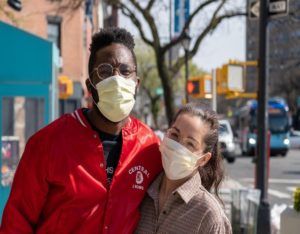Working (and Voting) for a Healthier Tomorrow
Here in California, our environment has been uniquely problematic these last weeks. High smoke from forest fires blocked the sun so one day so it seemed like we were having a solar eclipse all morning. The unprecedented huge fires, scorching heat, bad air, and high wind all point to the importance of voting for good environmental policy. I doubt you need a reminder to vote safely and soon.
And consider volunteering to encourage others to vote. Seed the Vote, Voter Protection Phonebank, Next Gen provide late-breaking opportunities. Feel free to contact me for more ideas. Nothing is more important for our democracy than voting and protecting the vote.
We at the Institute feel fortunate to be able to continue working from our homes on projects for a healthier environment along with our many colleagues. Earlier this month a shoe company executive, a congressional staffer, law professors, and scientists spoke at our interactive workshop on the science and policy of PFAS. Over two days, we shared strategies for translating PFAS science into policy and brainstormed new collaborative ideas for positive change—all on line. You can view the talks by clicking the image on the right and also below.
A couple other virtual events, both on November 30, that you can watch for free from the comfort of your home, are the very inspirational Goldman environmental awards and a major international PFAS meeting sponsored by the German Environmental Agency, where I’ll be presenting the opening keynote talk and closing remarks. More information is in our calendar below.
Our recent paper on managing PFAS as a class is an example of our communications strategy at work — the paper has been downloaded more than 23,000 times and is the most read article in ES&T letters right now. Extending the momentum, the lead author, our new Science and Policy Senior Associate Carol Kwiatkowski, published an op-ed in The Conversation. She explains how “the happy accident of Teflon’s discovery was, in fact, a train wreck,” and points to our paper’s recommendations as a way forward.
The concepts of PFAS as a class and essential use are making an impact in Europe. The EU’s new chemicals strategy aims to phase out all non-essential uses of PFAS–which would be enormous progress.
For now, we continue our scientific and policy work to reduce the use of chemical classes of concern. Since the pandemic began, the use of unnecessary and harmful antimicrobials has increased, and we are working to address that. Please check out our new fact sheet “Antimicrobials in the Time of Coronavirus: Consumer Products and Building Materials” where we describe how antimicrobials in many products are not needed and can do more harm than good.
We have heard many times that soap and water are more effective at washing away viruses than are antimicrobials. But did you know water is also washing away your blue jeans every time you launder them? And not only down the drain, but all the way to the Arctic. A recent paper found that over 50,000 microfibers can be shed from blue jeans every time they’re washed, and the fibers are ending up in fish and lake sediment in remote regions of the world. Although “natural”, these fibers are processed with dyes and other chemical additives. They are also persistent enough to survive long-range transport, raising concern over their impact on aquatic ecosystems. One way to help-wash your denim less!
Looking forward with optimism to the election,
Arlene
P.S. – One more reminder to be sure to vote as soon as possible and encourage your friends and family to vote.
A Tribute to Jamie Redford and Kirby WalkerOn a very sad note, our good friend the noted film producer and environmentalist, Jamie Redford passed away from cancer last week. Jamie and Kirby Walker, also an outstanding documentary film maker and environmental activist, produced the film Toxic Hot Seat which contributed to our country moving away from the use of cancer-causing flame retardants in furniture and baby products. Sadly, last year Kirby also died of cancer. We want to recognize Jamie and Kirby’s important contributions and the heartbreak of these kind and brilliant friends dying too young. Such tragedies help motivate our work to prevent cancer-causing chemicals in everyday products. |
PFAS Science & Policy Workshop TalksOur two-day interactive workshop on the science and policy of PFAS was held in conjunction with the PFAS in Our World conference. Please check out the short expert talks below.
|
Aerial Fire Retardants: It’s Raining RedTragically, this is already the worst fire season on record here in California and across the Western states, with unprecedented devastation from hundreds of simultaneous and uncontrolled wildfires. Are the bright red trails of fire retardant chemicals being dropped from airplanes to battle these blazes also harming people and wildlife? The good news is that aerial flame retardants are not the persistent, bioaccumulative and toxic chemicals that used to be added to furniture foam and are still used in plastic TV cases and building insulation. Most wildland fire fighting products are water based and not considered harmful to humans. However, they can cause unintended harm to ecosystems if they are not used carefully. Components of these mixtures can be toxic to aquatic life (for example, if they are dropped into streams). To prevent this, the US Forest Service has a policy of not dropping retardant within 300 feet of waterways. And that alarming bright red color is a dye added to mark areas where retardant has been dropped. Learn more in our blog. |
Squash the QuatsBy Anna Soehl Our new antimicrobial fact sheet has important information about quaternary ammonium compounds (QACs or quats), and other antimicrobials of concern that are being overused during this pandemic. Quats, which have been associated with antibiotic resistance, asthma, allergies and a wide range of health problems, are used in consumer and building products as well as in many cleaning products and disinfectants. Not surprisingly, their concentrations in residential dust have increased significantly during the pandemic. In a recent op-ed, researchers studying one of the quats–benzalkonium chloride–questioned whether that chemical belongs in consumer products. To date, research has not established a health benefit from embedding quats in durable products like furniture, school supplies and countertops. Also, while quats are effective in cleaning applications, many safer disinfectants can be used instead. Sadly, scientists are documenting wildlife deaths associated with antimicrobial exposure due to outdoor spraying of disinfectants and calling for better oversight and regulation of spraying practices. Both WHO and CDC discourage large scale spraying of quats and other disinfectants because of their ineffectiveness and potential for harm. |
Clearer Vision with Safe Simple SoapBy Seth Rojello Fernández If you’ve ever purchased prescription eyeglasses you know that lens coatings to prevent fogging are an option. Wearing face masks has increased the fogging problem, and thus more people are choosing anti-fog lens coatings or after-market wipes and sprays. But these products can contain harmful PFAS. The good news is that soap and water can be used to prevent fogging on eyeglasses (just as they can be used to fight COVID-19). As the soap and water dries, they leave behind a temporary film that acts as a barrier, preventing fog caused by your breath. Learn how to protect yourself from COVID-19 and foggy glasses safe simple soap in this short article. |
CalendarNovember 30: Goldman Environmental Prize 2020 Virtual Award Ceremony When: 4:00 pm – 5:00 pm PST The Goldman Environmental Prize is the “Nobel prize for environmental work” honoring grassroots environmental activists. Usually this moving event can only be viewed by a limited number of ticket holders, but this year’s fun and inspirational event will be a livestream hosted by Sigourney Weaver. The Goldman Ceremony is one of our Institute’s favorite events of the year. Register to watch here. November 30 & December 1: PFAS Conference in Berlin Dealing with Contaminants of Emerging Concern Arlene Blum will be the keynote speaker and lead the concluding panel for this international PFAS conference, Dealing with Contaminants of Emerging Concern, sponsored by the German Environment Agency and the German Ministry for the Environment. Her opening talk is entitled: “Reducing Harm from PFAS for a Healthier Environment “. You are invited to register free of charge here. |
